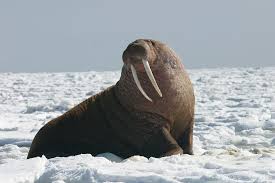Walruses: The fat potatoes of the sea
When somebody says the word “walrus”, what comes to mind first? Antarctica? Penguins? No, the walrus is something different. Walruses are part of the pinniped family, along with seals, sea lions, and many other creatures. It is generally considered the second largest of the pinnipeds. Some may still think of the walrus as a mystery even after this information, so the secrets of the walruses must be revealed.
What are pinnipeds? Are they fish? Although many may believe this to be true, this statement is incorrect. Pinnipeds are actually mammals. This means, unlike fish, they need to breathe air, and cannot live underwater without a source of it. This is not the only fact that may be shocking to many, as walruses are actually found near the north part of the globe. It is a common misconception that walruses live in Antartica, also known as the south pole. It is also known that walruses carry a large sum of fat and are very heavy. But just how heavy can a walrus be? The average weight for a male pacific walrus is 800 to 1,700 kilograms. In pounds, the highest average for a male pacific walrus is 3,748 pounds, or nearly 2 tons! It is because of the large amount of fat and weight in a walruses body that they gained a reputation as the couch potato of the sea, along with the manatee.
These couch potatoes have a few interesting features ready to explore. One of them is their tusks. The interesting thing about them is that they are actually canine teeth. They use these teeth to pull themselves out of the water and onto the ice. They also use them for gathering food. In this use, it is easy to catch their food, given the sharpness and length of their tusks. It’s not just food they use the tusks to attack, though, as they can be used for fighting back against or attacking other animals and even walruses. Another part of them is their whiskers. The real name for these whiskers is vibrissae. These vibrissae are highly sensitive, and they can be used to detect food/prey in the sea. The average walrus has 400 to 700 of these on their snout. Each of the whiskers has a muscle that allows them to separately move or attempt to locate food.
Although those features are interesting, what about their fat? Walrus fat is actually called blubber. Walruses have a thick layer of blubber beneath their skin, making them appear as though they are extremely fat. Although this layer may seem useless on the surface, it actually serves a purpose. This fatty layer serves as insulation for the walrus. This insulation is required as the water walruses swim in is extremely cold, and the blubber is a great help in trapping heat inside their bodies. Blubber really makes a difference in the winters, when temperatures are much too low for any creature to survive. The layer is actually several inches thick, and makes up a very large portion of a walruses body. Needless to say, blubber is extremely important to walruses.
To sum it up, walruses are very interesting and weird creatures. They are inside of the just as weird pinniped family. The walrus has many distinct features that aid it in surviving in its environment. Even though where it lives is extremely frigid, they have features that let them survive. In the end, walruses are very distinct animals, living in a very cold environment.
